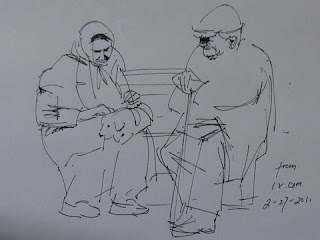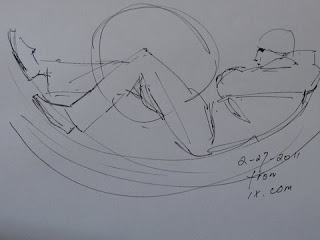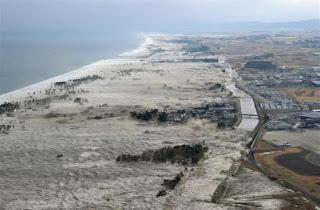The mournful violin solo dissolves into a lively street performance of Mozart played by three violinists and a bassist. Hu and Ai are at the
University of Westminster.
A blonde English woman with bad English teeth drives into the countryside to the home of John Gittings, “former reporter for The Guardian,” according to the subtitles as Mr. Gittings speaks in Chinese:
“Xin Hua Bookstores sold artwork, like posters, paper cuts, everything. I thought these could be used as teaching materials.”
What would be taught with this violent propaganda? The camera follows Bad Teeth and Bad Hair, Professor Harriet Evans, into “The Chinese Posters Collection Chamber” at the “Center for the Study of Democracy” (I did not make that up), which houses Mr. Gittings teaching material. Professor Evans says (in Chinese) that she took over for Mr. Gittings and recruited Teeth, Katie Hill, to help her “look after” the collection (after getting funding). “These are all paintings” says Professor Evans, opening a drawer, and then points to another drawer, “Here is some other stuff” (“stuff” being a technical, academic term). In an unfortunate sequence Ms. Hill is shown bending over some stuff, causing her long-sleeved shirt to ride up in the back. Just say no to crack.
That’s it for Little Women but not for Brits, unfortunately. Hu and Ai return to the pleasantly insipid voice that gave us “Chinese workers playtime” (“sort of”):
“In other respects the Chinese do take their pleasure seriously.”
This is a play on (English) words by Insipid. This is not “work hard/play hard;” Insipid means Chinese never take a break from the work of revolution. Ha-ha-ha-ha-ha:
“For a Cantonese a day off for the Chinese revolution: doing everything he could to educate [ the] students.”
That is what Insipid says, I have added only “the” and a colon to what is in subtitles. “Chinese revolution” should be “Cultural Revolution.” Eh, but maybe Insipid didn’t know that at the time. It is awkward usage of the language: “could” should be “can.” Okay fine, that’s picky. What about the “he” turning out to be a “she?” The Chinese “doing everything…to educate the students” is a woman, okay? That’s pretty stupid. That’s why this guy is Insipid:
“Studying the problems of [the]Revolution in this very office.”
“In this ‘vet-ty’ office.” Pan to portrait of Mao-as-student in the classroom:
“Chairman Mao’s life was an example of working hard and living very simply.”
"Vet-ty simply." From context, this is Insipid translating what the he/she is saying, not Insipid’s own insipid commentary.
This begins a painful part of the film because what the teacher goes on to say is:
“Rightists intended to usurp the leading power of the Revolution…claims it a capitalist revolution.(sic) The Traitor (sic) Liu Shaoqi madly opposed the working class’s armed movement.”
To Chinese at the time, there was nothing mad about the Mao-led charge that Liu was a “traitor” and “capitalist roader.” Suspension of disbelief failed only later in the Cultural Revolution when Lin Biao was similarly labeled. I have never been able to see the campaign against Liu through Chinese eyes. Liu was the president of the country for godssake. He literally wrote the book on how to be a good communist (“How to be a Good Communist”). He was Mao’s designated successor; he had become the de facto head of the country, in effect replacing Mao after standing up to Mao at the Seven Thousand Cadres Conference in 1962 and ending Mao’s crackpot Great Leap Forward-- and preventing the deaths of more than the 48,000,000 who had already died. He saved the country, for godssake. Now, in 1966, he’s a traitor? A “capitalist roader?” The guy who wrote “How to be a Good Communist” was planning a capitalist counter-revolution? Really?
No. Chinese, you were insane.
On July 29, 1966 Liu and Deng Xiaoping addressed 10,000 students in the Great Hall of the People. The meeting had been called—by Mao—to address how to go forward in the nascent Cultural Revolution. Liu and Deng didn’t have the foggiest idea how to go forward because they didn’t know what the Cultural Revolution was about, only Mao knew. Red Art picks up at this point. This is what Liu said:
“How to do the Proletarian Cultural Revolution? You said you were not sure and ask[ed] us for guidance: What to be done for the revolution? [To] be honest about it, I have to say, I don’t know either.”
Mao was literally behind a curtain listening at the time. A short while later the curtain opened and out strode Mao, pointedly ignoring Liu and Deng, to rapturous applause from the Hitler Youth. It was the beginning of the end for Liu, who was soon to be purged, tortured, kept alive to be further tortured, and so he could be formally expelled from the Party in 1969. They let him die on November 12, 1969.
Unbelievable. But not unbelievable to the Chinese people. They really got into it. Liu was savaged. Red Art picks up the story here with the painful scene of the schoolchildren mentioned in an earlier post.
They appear to be first-graders, second-graders, maybe even kindergarteners, they’re really little. They’re in a gymnasium-like building. A framed portrait of Mao is on the back wall, flanked by two Chinese flags. There are six kids performing on the floor of the gym for the other kids who are seated along the walls. Two of the six kids, little boys, hold a banner and chant:
“Long live Chairman Mao.”
The film fast-forwards a bit and the six are joined by another group of kids, it appears to be eight. A little girl from this second group steps forward:
“That bastard Liu Shaoqi…”
She stamps her foot and throws her right arm down, as if Liu is underfoot:
“…tried to teach us that learning is useless,…”
She raises her head and looks out on the audience, bringing her hand up to emphasize as she recites:
“…that learning is only for gaining office.”
She turns to the other kids to join in and then repeats the opening foot stomp and right arm gesture. All the kids in the second group now join her:
“Beat down the capitalist roaders in the Party. Long live Chairman Mao!
Nice.














































